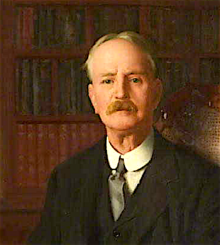
John Alfred Gotch was born in Kettering, Northamptonshire, England on 28 September 1852. After studying at Zurich University, he was articled to Robert Winter Johnson (1833-1884) in Melton Mowbray, Leicestershire and Kettering, Northamptonshire from 1871 to 1874. He also attended King's College, London and at the Architectural Association Schools in London. He worked in the office of James Taylor (1833?-1909) for four years. He also briefly worked in the office of Joseph Gales (1830-1906).
Gotch commenced practice as an architect in Kettering and London in 1879. Whilst training with Johnson, Gotch had become acquainted with Charles Saunders (1857-1944) and in c.1887 he joined Gotch in partnership. In 1899 Henry Ralph Surridge (1885-1954) joined the firm as an office junior and was made a Partner in 1930. At this paint the practice adopted the name Gotch, Saunders and Surridge (GSS). Gotch and Saunders subsequently retired on 31 December 1937.
Gotch was elected a Fellow of the Royal Institute of British Architects (FRIBA) in 1886 and a Fellow of the Society of Architects (FSA). He was President of the Architectural Association in 1886-1887; Vice-President of the Royal Institute of British Architects (VPRIBA) in 1914-1919; President of the Royal Institute of British Architects (PRIBA) from 1923 to 1925; and President of the Northamptonshire Association of Architects in 1911-1922.
In addition to his work as an architect, Gotch organised art classes in Kettering and became an authority on early Renaissance architecture. He was the author of several books including The Buildings of Sir Thomas Treeham (1883); Architecture of the Renaissance In England (1894); Early Renaissance Architecture in England (1901) The Growth of the English House (1909); The Original Drawings for the Palace at Whitehall, attributed to Inigo Jones (1912); Domestic Architecture of the Georgian Period (1917); The English Home from Charles I. to George IV (1918); Inigo Jones (1928); and The Old Halls & Manor-Houses of Northamptonshire. An Illustrated Review (1936).
Gotch died in Kettering on 17 January 1942 Gotch's brother was the painter and illustrator Thomas Cooper Gotch (1854-1931).
Works by Gotch and his practice between 1879 and 1923 included Clopton Manor House, Thornby Grange, the Gables, and other houses in Peterborough; St. Mary's Church, Kettering; elementary and secondary schools at Kettering, and for the County Councils of Northamptonshire and Bedfordshire; numerous banks throughout the country for the London Joint City and Midland Bank, Ltd.; workhouses, houses, factories; War memorials (Kettering, Northamptonshire, 1921 and Hinckley, Leicestershire, 1922); works of preservation in ancient houses; and the Alfred East Art Gallery in Kettering [Source: Who's Who in Architecture 1923. Edited by Frederick Chatterton. London: The Architectural Press, 1923].
In a period of nine years following World War One, Gotch & Saunders designed and built over 140 branches for the Midland Bank, notable among which was the Bank’s headquarters in Poultry, London, in association with Sir Edwin Lutyens.
Directory of British Architects 1834-1914. Compiled by Antonia Brodie, et al. Volume 1: A-K. London; New York: British Architectural Library, Royal Institute of British Architects/Continuum, 2001
Gray, A. Stuart. Edwardian architecture: a biographical dictionary. London: Gerald Duckworth & Co., Ltd., 1985
Marriott, Charles. Modern English Architecture. London: Chapman & Hall, 1924
‘Obituary’. Architect & Building News vol. 169, 30 January 1942, p. 92
‘Obituary’. Architect's Journal vol. 95, 22 January 1942, p. 69
‘Obituary’. Architect's Journal vol. 95, 29 January 1942, p. 86
‘Obituary’. Architect's Journal vol. 95, 5 February 1942, pp. 107-108
‘Obituary’. The Builder vol. 162, 23 January 1942, p. 78
‘Obituary’. RIBA Journal vol. 49, 1942, pp. 37, 66-67
Who’s Who in Architecture 1914. London: Technical Journals Ltd., 1914
Who’s Who in Architecture 1923. Edited by Frederick Chatterton. London: the Architectural Press, 1923